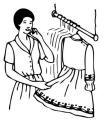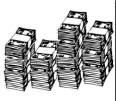GEAR UP FOR LIFE
MATH MENTOR:
Finding percentages - Part 1
You are faced with percentages everywhere you go.
| In stores |
They have a 25% off sale! |
| In businesses |
My realtor wants 6% of the sale price. |
| Making loans |   I can get a 10% interest loan on the van. |
| Farming |
I've sold 60% of my crop this year! |
| Saving money |
My investment will pay me a 4% interest! |
When you talk about percentages, you are talking about parts of a whole. The whole is always considered 100%.
You might hear someone say, "He gave 150% of his effort to the cause." Of course, that can't be. No one can give more than all, or 100%.
WHOLE = 100%
Start with the idea of 100% meaning the whole.
- If you borrow $200.00, then $200.00 is 100%.
- If a shirt is $23.50, then $23.50 is 100% of the cost.
- If you saved $732.62 last year, then $732.62 is 100% of the amount you save.
- If your church has 275 members, then 275 represents 100% of the membership.
- If your employer hires 32 employees, then 32 represents 100% of that company's employees.
Now that we have the whole, let's talk about parts of the whole. When you begin to calculate, you will calculate real numbers.
It is important to remember that the percent symbol (%) is just a symbol. It tells you that the real number is expressed in hundredths. You don't calculate symbols. You calculate the numbers they represent. When you see the % symbol, you must divide by 100 ("Cent" in the word percent refers to hundredth).
50% represents one half of the whole. When you calculate, you must represent the percentage as a real number.
To find the number symbolized, divide the percentage number by 100 to find the hundredth expression, or the decimal. 50% ÷ 100 = 0.50
- 25% represents one fourth of the whole.
25% ÷ 100 = 0.25- 10% represents one tenth of the whole.
10% ÷ 100= 0.10- 75% represents three fourths of the whole.
75% ÷ 100= 0.75- 100% represents the whole.
100% ÷ 100 = 1Division is expressed with different symbols - ÷ , __ , and / (See the symbols used below.)
25 ÷ 100 =
= 25/100
The next step is to take a number and find out how much each percentage represents. To do that, you multiply the number by the percentage.
Let's assume that you borrowed $200.00.
$200.00 = 100%
How much is 50% of $200.00? Multiply $200 by.50 (whole X % ). Follow the same procedure for finding all other percentages.
| 50% |
200 X .50 = 100 |
$100.00 |
| 25% |
200 X .20 = 50 |
$ 50.00 |
| 10% |
200 X .10 = 20 |
$ 20.00 |
| 75% |
200 X .75 = 150 |
$150.00 |
Let's try other amounts.
The listed price of a motorcycle is $3,500.00, which is 100% of the price. (Think of blue as the whole, green as the part, and orange as the percentage.)
| $ 3,500 X 1 = $3,500.00 | 100 % |
| $ 3,500 X 0.50 = $1,250.00 | 50% |
| $3,500 X 0.25 = $875.00 | 25% |
| $3,500 X 0.10 = $350.00 | 10% |
| $3,500 X 0.75 = $2,625.00 | 75% |
Use the same formula to fill out the part represented by the percentages in the items below.
1. A hospital bill is $2,900.00. What do each of the percentages represent in cost?
| 1 | 100 % |
| 2 | 50% |
| 3 | 25% |
| 4 | 10% |
| 5 | 75% |
2. Tuition at the Technical School is $ 450.00 for a 3-credit-hour course.
| 1 | 100 % |
| 2 | 50% |
| 3 | 25% |
| 4 | 10% |
| 5 | 75% |
3. The bank will loan $850.00.
| 1 | 100 % |
| 2 | 50% |
| 3 | 25% |
| 4 | 10% |
| 5 | 75% |
The same process applies to other percentages. To find the percentage amount, multiply the part (hundredth) by the whole number.
For example, 30% would be expressed as 0.30; 45% as 0.45, 9% as 0.09; 6% as 0.06; 60% as 0.60 and so on.
If you want to tip a waitress 20% for a meal that cost $12.50, you would multiply $12.50 by 0.20. You would tip her $2.50.
Find the amounts that represent the following percentages from each of the totals.
From a total of 900.
| 1 | 15% |
| 2 | 35% |
| 3 | 80% |
| 4 | 90% |
| 5 | 60% |
From a total of 640.
| 1 | 15% |
| 2 | 45% |
| 3 | 30% |
| 4 | 80% |
| 5 | 65% |
From a total of 10,500.
| 1 | 95% |
| 2 | 40% |
| 3 | 12% |
| 4 | 46% |
| 5 | 52% |
From a total of 170.
| 1 | 15% |
| 2 | 35% |
| 3 | 80% |
| 4 | 90% |
| 5 | 60% |
Here's an image to review what we've learned. We'll complete the circle in the next two parts.
P = Part % = Percentage W = Whole ? = The item you want to find

To find the part, multiply the whole by the percentage.
Close this window to
return to your unit. If you want, you may also continue to Part 2 in order to learn
other formulas for percentages.






